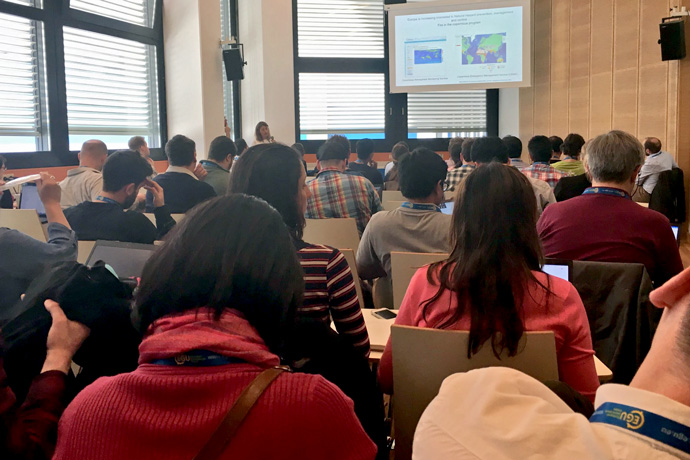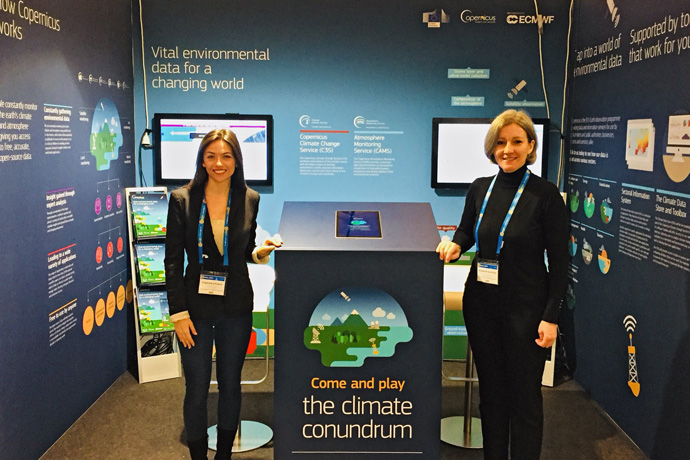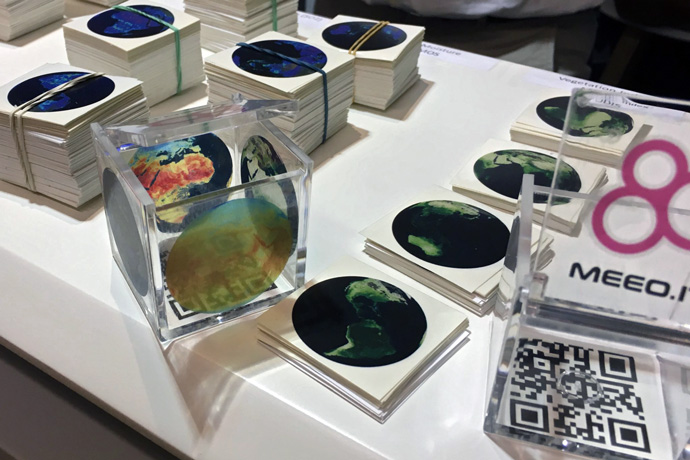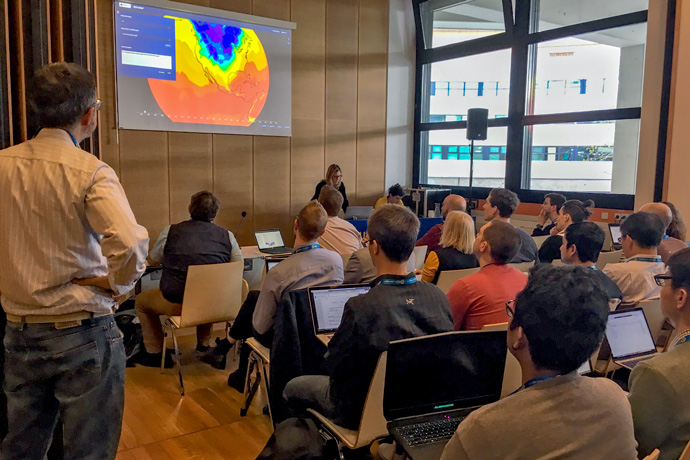

Poster sessions co-convened by ECMWF scientists were popular with conference participants.
ECMWF scientists delivered several well-received talks and courses at the European Geosciences Union (EGU) General Assembly from 8 to 13 April in Vienna, where numerical weather prediction (NWP) was generally strongly represented.
Discussions with other scientists led to useful insights and potential future collaborations.
The EU-funded Copernicus Climate Change Service (C3S) and the Copernicus Atmosphere Monitoring Service (CAMS), both implemented by ECMWF, used the event to update participants on recent developments, such as the C3S Climate Data Store and the use of observations from the recently launched Sentinel-5P satellite.
Weather forecasting
ECMWF was well represented in the EGU’s NWP session. Lead Scientist Roberto Buizza delivered an invited talk on ECMWF's Strategy to 2025, and Irina Sandu gave presentations on wind turning biases in NWP models and on the constraints of orographic drag parametrizations using kilometre-scale simulations.
Irina was also part of the panel of a town hall meeting organised by the Horizon 2020 APPLICATE project and the coordinating office of the Year of Polar Prediction (YOPP).
“In the session about post-processing ensemble forecasts, we could see increased interaction between the meteorological and statistical communities, which is a welcome development,” says ECMWF scientist Thomas Haiden, a veteran of EGU general assemblies.
ECMWF’s contributions on downscaling and point rainfall, on precipitation type, and on 3-D visualisation of sting jets all attracted large audiences and much discussion, opening up the prospect of collaborations with institutions in the UK, Switzerland, Germany, USA and Nepal.

A course on wildfires given by ECMWF scientists was well attended.
A poster from the Finnish Meteorological Institute discussed albedo variation over forested, snow-covered terrain. It shows that reflectivity goes down early and late in the day. “This may relate to a consistent local negative bias in spring-time evening temperatures in ECMWF forecasts,” says ECMWF scientist Tim Hewson. “The poster is an example of how conference participation can potentially help improve the quality of ECMWF's forecasts in key areas.”
ECMWF’s Francesca Di Giuseppe convened a new, lively session on sub-seasonal to seasonal prediction. “The idea for this event was to create a community that can meet every year in Vienna and discuss issues related to predictability at this scale,” Francesca says.
Computing and big data
ECMWF scientist Peter Düben convened a session with 12 talks and many posters on ‘High resolution weather and climate models on large supercomputers’.
ECMWF Deputy Director of Research Peter Bauer was one of the speakers and his talk was very well received.
“Overall the session was a great success and we managed to keep the room overcrowded with people standing until 5 p.m. on Friday afternoon,” Peter Düben notes.

The Copernicus services operated by ECMWF had a stand at the conference.
This EGU was also the last opportunity to publicly present the work of the EU-funded Horizon 2020 EarthServer-2 project.
ECMWF’s Julia Wagemann and Stephan Siemen delivered a course on Open Geospatial Consortium (OGC) web services. “The course was very successful, with over 45 participants,” Stephan says. “Clearly there was much interest in how to use OGC standards to access data.”
Copernicus services
Cedric Bergeron and Carlo Buontempo (both ECMWF) and Alessandro Amici (BOPEN) delivered the first training course on the Climate Data Store that C3S has organised for an external audience.
Despite the 8:30 a.m. start, some 50 people participated. “The course raised a number of interesting and complex questions,” says Carlo. “There was a generally high level of interest from the participants, and some of them decided to stay beyond the end of the session to discuss some of the more technical elements of the implementation.”

Conference participants could build their own ERA-Interim data cube.
Additional talks given by Carlo and ECMWF’s Anabelle Guillory were an opportunity for scientists to find out more about C3S, the Climate Data Store and the applications that users can build.
ECMWF’s Claudia Vitolo , Francesca Di Giuseppe , Mark Parrington and Julia Wagemann gave a well-received course on how to make use of Copernicus data to analyse emissions from wildfires, generate danger maps and quantitatively assess impacts on affected population.
Participants were also invited to take part in the ECMWF Summer of Weather Code programme and the 2018 Hackathon.
ECMWF’s Richard Engelen gave an overview of how atmospheric composition observations from Sentinel-5P will be used in CAMS. His presentation also covered the early testing of the first Sentinel-5P data, which provides valuable feedback to the data providers.
Mark Parrington co-convened and presented at a session on the unprecedented wildfires and smoke plumes seen in 2017. The session covered how intense wildfires can induce thunderstorms and pyroconvection.

A course on OGC web services given by ECMWF’s EarthServer-2 team elicited a lot of interest.
Johannes Flemming co-convened a session on ‘Chemistry, climate, and weather feedbacks in the Earth system’, and Angela Benedetti participated in meetings entitled ‘Towards Integrated Air Quality Prediction and Forecast Systems in Africa’ and ‘Chemistry-meteorology/climate modelling (CCMM)’.
“As one of the outcomes, I proposed an International Year of African Prediction to help bring efforts related to Africa together,” Angela says.
Big and growing
The EGU General Assembly continues to grow. In 2018, more than 15,000 scientists from over 100 countries participated in it. More than half of these were under the age of 35.
ECMWF made an impact at the event not just through posters and presentations. There was ample evidence that ECMWF output continues to be held in very high regard by other scientists.
“Numerous references were notably made to the ERA-Interim reanalysis, but ECMWF’s everyday forecasts, the OpenIFS project and boundary condition usage were also referenced many times,” Tim Hewson says.
Finally, ECMWF Fellow Tim Palmer from the University of Oxford was awarded the L. F. Richardson medal during the meeting for his many contributions to meteorology. These include a pivotal role in setting up ECMWF's ensemble forecasting system.
